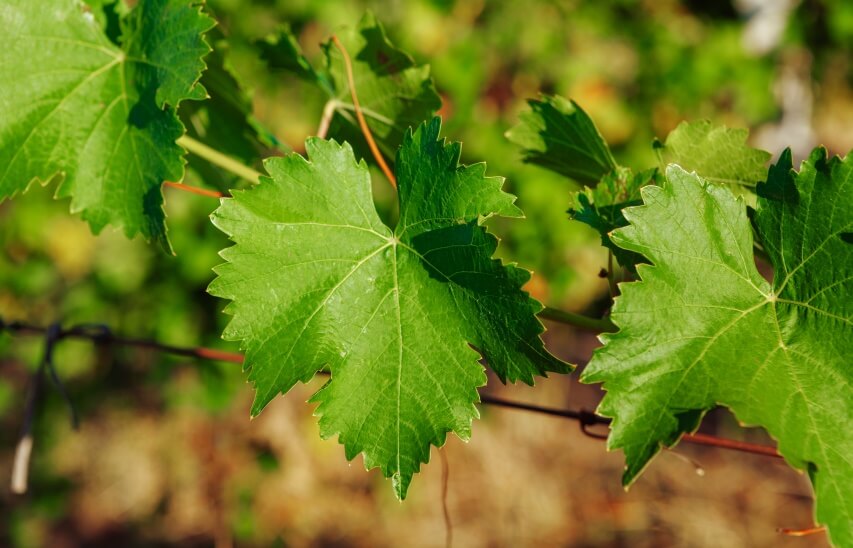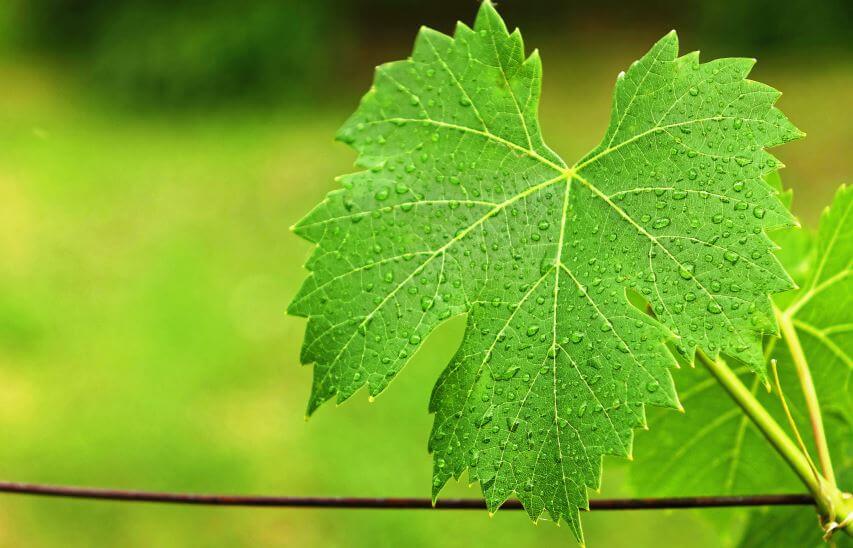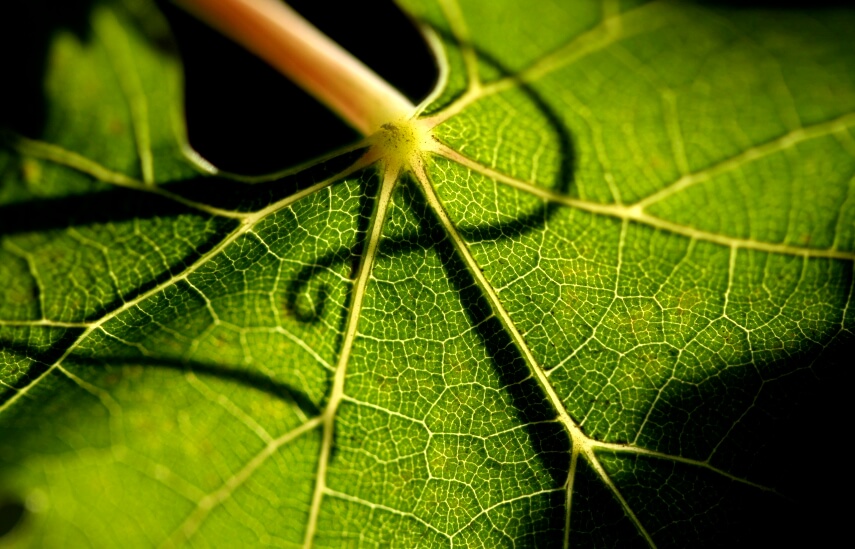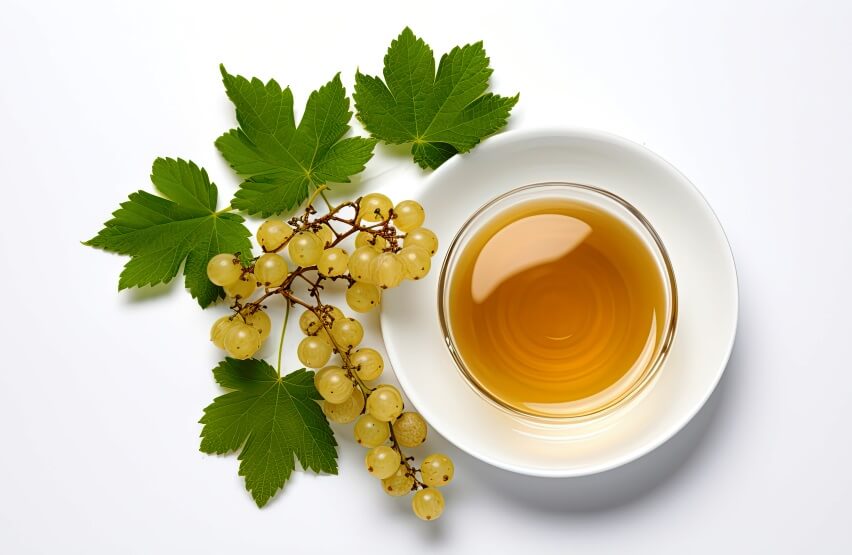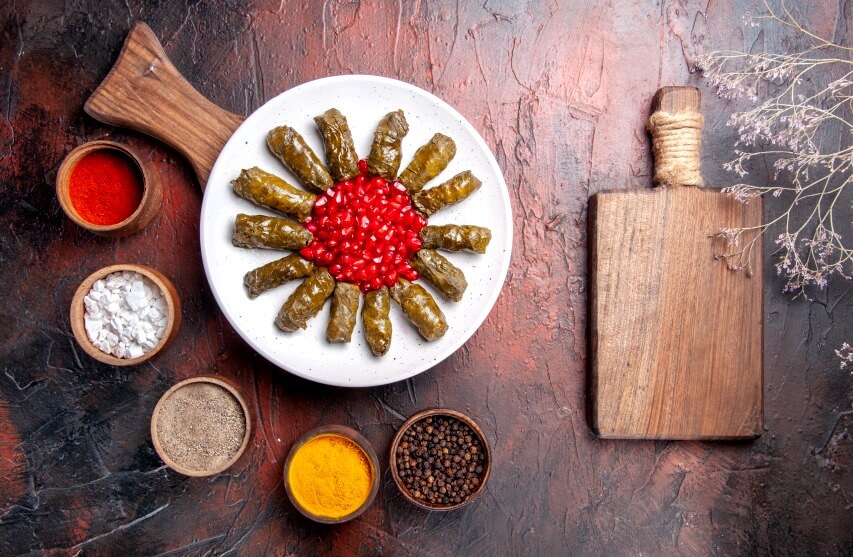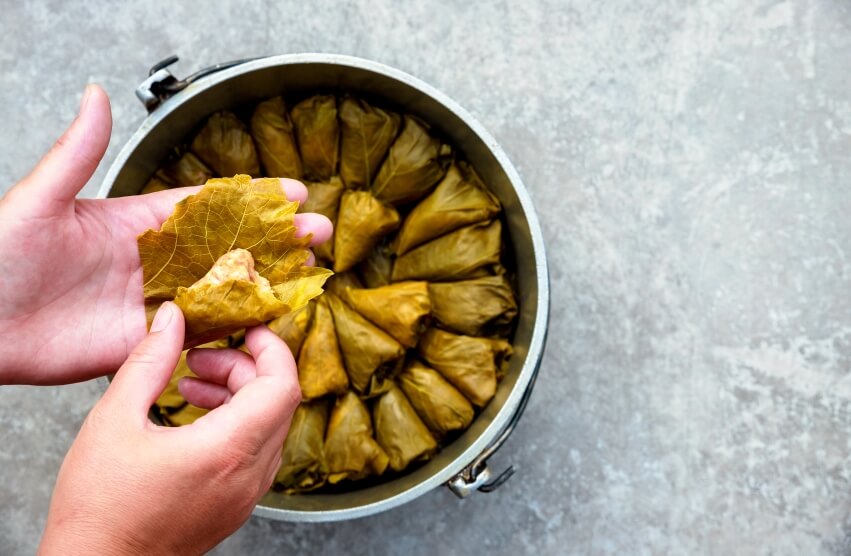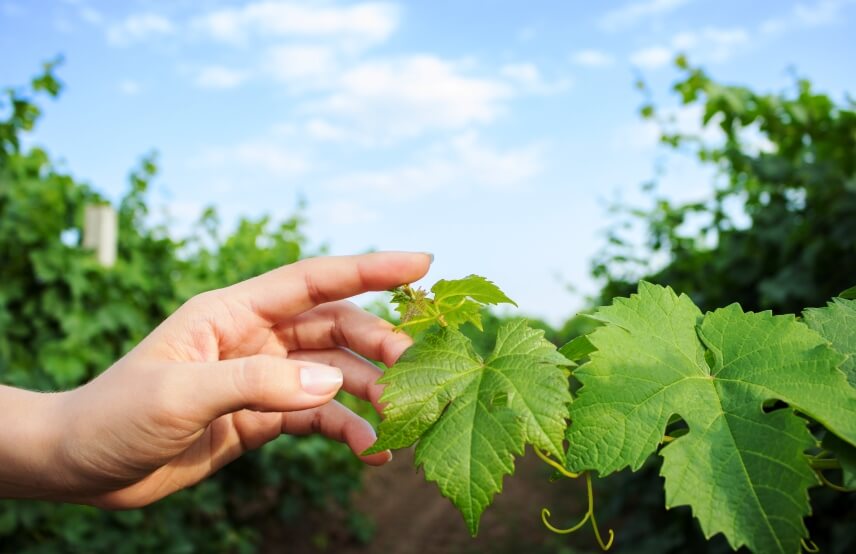Grape (Vitis vinifera) leaves, known for their culinary uses in dishes such as dolmas and stuffed grape leaves, have a long history of consumption in various cultures worldwide. Beyond their culinary appeal, grape leaves are also valued for their potential health benefits. This article will discuss the uses and health benefits of grape leaves. It will also explore how to prepare grape leaf tea and use it in cooking and culinary practices.
If you are interested in this topic, you can also read
<<Benefits Of Violets>> and <<Coriander seeds Benefits>> articles.
Grape Leaf Benefits
Grape leaves contain a diverse array of phytochemicals, including polyphenols, flavonoids, tannins, and vitamins. This section explores the phytochemical composition of grape leaves and discusses the potential health-promoting properties of these bioactive compounds. Here are some of the key health benefits of grape leaves:
Anti-Oxidant Properties
Grape leaves contain a variety of anti-oxidants, including flavonoids, polyphenols, and tannins.
These anti-oxidants counteract damaging free radicals within the body, thereby diminishing oxidative stress and inflammation. This, in turn, helps decrease the likelihood of developing chronic ailments such as cardiovascular disease, cancer, and neurodegenerative disorders [1, 2].
Anti-Inflammatory Effects
Compounds found in grape leaves have demonstrated anti-inflammatory properties, which may help reduce inflammation throughout the body. Chronic inflammation is linked to various health conditions, including arthritis, heart disease, and certain cancers [3].
Heart Health
The anti-oxidants and other bioactive compounds in grape leaves may contribute to heart health by promoting healthy blood circulation, reducing oxidative damage to blood vessels, and lowering cholesterol levels. Consuming grape leaves as part of a balanced diet may help support cardiovascular function and reduce the risk of heart disease [4].
Digestive Health
Grape leaves are a good source of dietary fiber, which is essential for digestive health. Fiber encourages consistent bowel movements, alleviates constipation, and fosters the growth of beneficial bacteria in the gut. Additionally, the presence of phytochemicals in grape leaves may help soothe gastrointestinal inflammation and improve digestive function [5].
Blood Sugar Control
Some research suggests that compounds found in grape leaves may help regulate blood sugar levels and improve insulin sensitivity. This could benefit individuals with diabetes or those susceptible to this condition. However, more research is needed to fully understand the mechanisms behind this potential benefit [6].
Anti-Microbial Properties
Grape leaves contain certain compounds that exhibit anti-microbial activity against bacteria, fungi, and viruses. These anti-microbial properties may help protect against infections and support immune function [7, 8].
Skin Health
The anti-oxidants and vitamins found in grape leaves may contribute to healthy skin by protecting against UV damage, reducing inflammation, and promoting collagen production. Incorporating grape leaves into your diet may help support overall skin health and appearance [9].
Nutritional Value
While not a primary source of nutrition, grape leaves provide vitamins, minerals, and dietary fiber, contributing to overall nutrient intake and promoting general well-being.
Grape Leaf Nutrition Info
Grape leaves, while not typically consumed in large quantities, offer a range of nutritional benefits due to their rich phytochemical composition. Here is an overview of the nutritional components found in grape leaves [10]:
Nutritional value of grapevine (cv. Chardonnay) leaves [11]
| Chemical Components | Amount |
| Moisture (%) | 7.76 |
| Oil (%) | 1.81 |
| Protein (%) | 15.39 |
| Carotenoid (µg/g) | 46.96 |
| Total phenolic (mg GAE/100 g) | 1724.40 |
| Total flavonoid (mg QE/100 g) | 8421.43 |
| Antioxidant activity (mmol TE/kg) | 20.79 |
| Minerals | Content (mg/kg) |
| P | 3527.58 |
| K | 10174.34 |
| Ca | 13947.65 |
| Mg | 2615.49 |
| Na | 193.32 |
| Fe | 82.52 |
| Mn | 84.12 |
| Ni | 0.82 |
| Pb | 6.54 |
| Zn | 34.43 |
| B | 23.43 |
| Cu | 22.26 |
Minerals
Grape leaves are a good source of minerals such as calcium, magnesium, iron, potassium, and manganese. These minerals are essential for bone health, muscle function, nerve transmission, and overall metabolism [12, 13].
Fiber
Grape leaves are rich in dietary fiber, including both soluble and insoluble fiber. Fiber is crucial for digestive health, promoting regular bowel movements, reducing cholesterol, and controlling blood sugar levels.
Anti-Oxidants
Grape leaves contain a variety of anti-oxidants, including flavonoids, polyphenols, and tannins. These anti-oxidants help neutralize harmful free radicals in the body, thereby protecting cells from oxidative damage and reducing the risk of chronic diseases such as heart disease, cancer, and neurodegenerative disorders.
Phytochemicals
Beyond vitamins and minerals, grape leaves contain various phytochemicals with potential health benefits. These include resveratrol, quercetin, and catechins, which have been associated with anti-inflammatory, anti-microbial, and anti-cancer properties.
Low In Calories
Grape leaves are low in calories, making them a fitting addition to a well-rounded diet for individuals mindful of their calorie consumption.
Hydration
Like other leafy greens, grape leaves have a high water content, contributing to hydration and overall fluid balance in the body.
It is important to note that the nutritional content of grape leaves may vary depending on factors such as variety, growing conditions, and preparation methods. While fresh grape leaves are preferable for consumption, preserved grape leaves, such as those found in jars, may still retain some nutritional value but could have higher sodium content due to preservation methods. Incorporating grape leaves into your diet as part of dishes like dolmas or salads can provide a nutritious boost and diversify your intake of vitamins, minerals, and anti-oxidants.
Grape Leaf Benefits For Male
Grape leaves offer several potential health benefits for males, attributed to their rich phytochemical composition and nutritional profile. Here is a specific benefit that may be particularly relevant to men:
Prostate Health
Some research suggests that the anti-oxidants found in grape leaves, such as polyphenols and flavonoids, may have protective effects against prostate cancer. These compounds have been shown to inhibit the growth of prostate cancer cells and reduce inflammation in the prostate gland, potentially lowering the risk of developing prostate cancer or alleviating symptoms associated with benign prostatic hyperplasia [14].
Grape Leaf Benefits For Female
Grape leaves offer various health benefits for females, supported by their rich phytochemical composition and nutritional content. Here are some specific benefits that may be particularly relevant to women:
Hormonal Balance
Compounds found in grape leaves may help support hormonal balance in women. Some research suggests that certain phytochemicals in grape leaves, such as resveratrol, may have estrogenic effects, which could benefit women experiencing hormonal fluctuations associated with menopause or menstruation [15].
Menstrual Health
Some women experience symptoms such as bloating, cramping, and mood swings during menstruation. The anti-inflammatory properties of grape leaves may help alleviate these symptoms by reducing inflammation and discomfort associated with menstruation [16].
Grape Leaf Side Effects
While grape leaves are generally safe for consumption and offer numerous health benefits, there are some potential side effects and considerations to be aware of [17, 18]:
Allergic Reactions
Some individuals may be allergic to grape leaves or components found within them. Allergic reactions can range from mild to severe and may include symptoms such as itching, swelling, hives, difficulty breathing, or anaphylaxis. If you have known allergies to grapes or other related foods, exercise caution when consuming grape leaves and consult a healthcare professional if you experience any adverse reactions [19].
Oxalate Content
Like numerous leafy greens, grape leaves contain oxalates, substances that may exacerbate the formation of kidney stones in susceptible individuals. If you have a history of kidney stones or are prone to their development, it’s prudent to moderate your consumption of oxalate-rich foods like grape leaves [20].
Interactions With Medications
Certain compounds found in grape leaves, such as resveratrol, may interact with medications or affect their metabolism in the body. If you are taking medicines for any health condition, especially blood thinners, anti-diabetic drugs, or medications metabolized by the liver, consult with a healthcare professional before incorporating grape leaves into your diet to avoid potential interactions.
Digestive Issues
Some individuals may experience digestive discomfort or gastrointestinal upset after consuming grape leaves, particularly if they are not accustomed to eating or consuming them in large quantities. Symptoms may include bloating, gas, or diarrhea. Start with small portions of grape leaves to gauge your tolerance and listen to your body’s response.
Pesticide Residues
Conventionally grown grape leaves may contain pesticide residues, which could pose health risks if consumed in high quantities. To minimize pesticide exposure, consider choosing organic or pesticide-free grape leaves whenever possible, especially if you plan to consume them regularly.
Pregnancy And Breastfeeding
While grape leaves are generally considered safe for most people, pregnant or breastfeeding women should exercise caution and consult a healthcare professional before consuming them in large amounts, especially if they have concerns about allergies, oxalate intake, or medication interactions.
Overall, grape leaves are a nutritious and versatile food that can be enjoyed as part of a balanced diet. However, it is essential to be mindful of potential side effects and considerations, particularly if you have specific health concerns or dietary restrictions. Before making any dietary alterations, seeking personalized guidance from a healthcare professional is recommended.
How To Make Grape Leaf Tea?
Grape leaf tea is a flavorful and potentially healthful beverage made using fresh or dried grape leaves. Here is a simple recipe to make grape leaf tea [21, 22]:
Ingredients:
- Fresh or dried grape leaves (make sure they are pesticide-free if using fresh leaves)
- Water
- Optional: sweeteners such as honey or sugar, lemon slices, or herbs like mint for added flavor
Instructions:
- When using fresh grape leaves, wash them meticulously under running water to eliminate dirt or debris. If you are using dried grape leaves, there is no need to wash them.
- Fill a pot with water and bring it to a boil.
- Add the grape leaves to the pot once the water is boiling. Depending on your preference for flavor intensity, use about 2-3 grape leaves per cup of water.
- Allow the grape leaves to simmer in the water for about 5-10 minutes. Keep an eye on the pot to prevent boiling over.
- After simmering, remove the pot from heat and let the tea steep for an additional 5-10 minutes. This allows the flavor of the grape leaves to infuse into the water.
- Strain the tea using a fine mesh strainer or cheesecloth to remove the grape leaves. You can discard the grape leaves or save them for another use.
- If desired, sweeten the tea with honey, sugar, or your preferred sweetener to taste. You can also add a squeeze of lemon juice or a sprig of fresh mint for added flavor.
- Pour the tea into cups and serve hot. You can also chill the tea in the refrigerator and serve it over ice for a refreshing, cold beverage.
Enjoy your homemade grape leaf tea!
How To Eat Grape Leaf?
Grape leaves are versatile and can be eaten in various ways, both raw and cooked. Here are some standard methods for preparing and enjoying grape leaves:
Stuffed Grape Leaves (Dolmas)
One of the most popular ways to eat grape leaves is by stuffing them with a flavorful mixture of rice, herbs, and spices to make dolmas. To prepare stuffed grape leaves, blanch fresh ones in boiling water for a few seconds to soften them. Then, place a spoonful of the rice mixture on each leaf, fold the sides over the filling, and roll tightly into a small bundle.
Arrange the stuffed grape leaves in a pot, lay them tightly, and cover them with water or broth. Simmer gently until the rice is cooked and the grape leaves are tender. Serve the stuffed grape leaves hot or cold, garnished with lemon wedges and yogurt sauce.
Grape Leaf Wraps
Use fresh grape leaves as a wrapper for various fillings, such as grains, vegetables, or meat. Simply blanch the grape leaves to soften them, then wrap the desired filling inside, similar to a burrito or spring roll. These wraps can be enjoyed as a light and healthy appetizer or snack.
Grape Leaf Salads
Fresh grape leaves can be thinly sliced and added to salads for a unique flavor and texture. Pair them with ingredients like tomatoes, cucumbers, olives, feta cheese, and a lemon-olive oil dressing for a Mediterranean-inspired salad [23].
Stuffed Grape Leaves (Dolmas)
Grape Leaf Pesto
Blend blanched grape leaves with garlic, nuts (such as pine nuts or walnuts), Parmesan cheese, olive oil, and lemon juice to make a flavorful pesto sauce. Use grape leaf pesto as a spread for sandwiches or wraps, or toss with cooked pasta for a quick and tasty meal [24].
Garnish Or Wrap For Grilled Foods
Wrap fish, poultry, or other proteins in grape leaves before grilling to infuse them with a subtle flavor and keep them moist. Use fresh grape leaves as a decorative garnish for plates or platters, adding a touch of elegance to your presentation.
Grape Leaf Rolls
Roll fresh grape leaves around ingredients like cheese, roasted vegetables, or cured meats for a simple and tasty snack or appetizer.
Pickled Grape Leaves
Preserve fresh grape leaves by pickling them in a brine of vinegar, salt, and spices. Pickled grape leaves can be used as a tangy addition to sandwiches, salads, or mezze platters [25].
Whether you stuff, wrap, or garnish grape leaves, they add a unique flavor and texture to a variety of dishes, making them a versatile ingredient in Mediterranean and Middle Eastern cuisine.
Conclusion
Grape leaves represent a rich source of bioactive compounds with potential health-promoting effects. While more research is needed to fully understand their mechanisms of action and therapeutic applications, the existing evidence suggests that grape leaves may offer significant benefits for human health. Incorporating grape leaves into the diet or exploring their potential as therapeutic agents may hold promise for promoting health and preventing disease.



